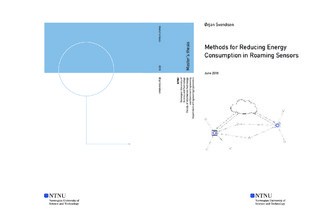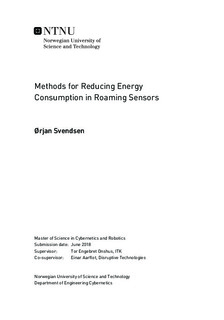| dc.description.abstract | Wireless sensors keep getting smaller and cheaper; however, most of them still run on batteries, so keeping their energy consumption low is as important as ever. There are numerous ways to achieve this, both on a sensor level and on a network level. As such, there is no standard network structure for wireless sensor networks.
In this thesis, a multi-sink, single-hop wireless sensor network is studied. This is a rather unconventional network, where sensors broadcast messages to all gateways in their vicinity, and the gateways forward messages between the sensors and the control center, which is also known as the cloud. Due to this design, the sensors may roam even when their physical location remains fixed, as external interference may alter which gateways they can reach.
This roaming can potentially lead to increased energy consumption in the sensors for several reasons. Some scenarios where this happens are identified in this thesis, and ways of reducing this increase are proposed. These scenarios are mainly related to address assignment and gateway selection, of which the latter was decided to look into.
The gateway selection problem is related to the fact that each sensor has an encrypted session with the cloud, and so the gateways are unable to read the content of any messages. In practice, this means that all replies must be created by the cloud and forwarded to a gateway, that in turn will send this reply to the sensor. Due to the high latency of the Internet, these replies need to be created and forwarded in advance.
If a sensor does not receive a reply in time, it will make several retransmission attempts, which naturally increases its energy consumption. Besides this, the sensors also have an operating mode called boost mode, in which they can communicate over longer distances at the expense of higher energy consumption. Seeing as the sensors may also roam, selecting which gateways to send replies via is not a trivial problem.
In this thesis, a transmission power control algorithm, ways of detecting retries and monitoring connection reliability, as well as four methods for selecting which gateway to forward replies to, are presented.
The simplest method selects gateways based on which gateway that has the best average signal strength for each sensor. This method is called the best average signal strength (BASS) method. The second one selects gateways based on how many retransmissions that occurred while they were responsible, and so it is called the lowest retry count (LRC) method. A further development of this method monitors the reliability of each individual connection and always selects the gateways with the highest connection reliability (HCR) to each sensor. The final method attempts to estimate the expected energy consumption for each sensor based on the reliability of the connections, and then it selects the gateway that leads to the lowest expected energy consumption (LEEC) for each sensor.
Due to the unconventionality of this wireless sensor network, no wireless network simulator that could be used as-is was found. Therefore a new simulator was implemented from scratch, and the rationale behind its design is discussed extensively in this thesis. The gateway selection methods were implemented in the simulator, and each of them were simulated five times on 12 different networks in order to test them under varying conditions.
The results show that transmission power control lead to a reduction of the energy consumption in the networks by more than 11%, despite causing a considerable increase in the number of retries and transmission in boost mode. It is therefore considered a success, and by improving the algorithm such that it causes fewer retries and transmissions in boost mode, the energy consumption could be reduced even further.
With boost mode enabled, LEEC was able to achieve the lowest energy consumption out of all the methods by minimizing the amount of boost transmissions. On average the energy consumption was just over 21% lower than for the closest competitor. For a wireless sensor, reducing its energy consumption by this much is very good, so this gateway selection method definitely works well. This was achieved by using a large window size for the calculation of average signal strength and connection reliability.
However, with a small window, and a huge amount of retransmissions, BASS consistently gave the lowest energy consumption. Not as low as LEEC with a large window, but on average a little over 19% lower than any other methods with a small window. It is therefore clear that the performance of these methods depends heavily on the window size, which should be adjusted according to the rate of change of the connection s properties. It also seems like having few transmissions in boost mode is more important than causing few retransmissions, if energy consumption is to be reduced.
Nevertheless, the proposed methods work quite well, and together with the simulator, they form a solid basis for future research on the issue of gateway selection in multi-sink, single-hop wireless sensor networks, where the sensors are prone to roaming. | |

